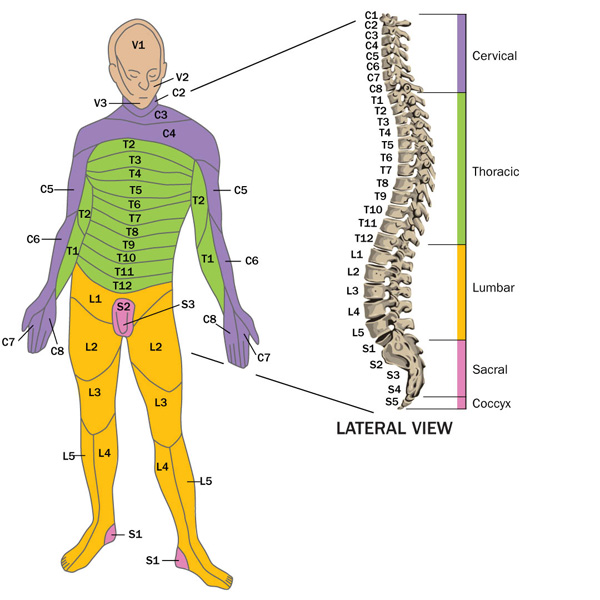7 cervical vertebrae – neck (C1 to C7)
12 thoracic vertebrae (T1 to T12)
5 lumbar vertebrae – lower back (L1 to L5)
5 sacral vertebrae (S1 to S5)
4 fused vertebrae that form the coccyx

The spine may be compared to a flexible tube. The holes in the centre of each vertebrae form the spinal canal. Through the interior passes a ‘cord’ of nervous tissue called the ‘spinal cord’. The spine’s principal function is to protect the spinal cord.
Your Spinal Cord
The spinal cord which is made of nerve cells and nerve fibres, resembles a cable about the size of your little finger.
Approximately 21 inches (52.5cm) in length, it begins at the base of your brain and passes through the interior of each of your cervical and thoracic vertebrae. It ends at the upper level of your lumbar vertebrae (the superior border of L2), where it branches into a collection on nerves that extend down to the region of the coccyx.
Simply put, the spinal cord works like a two-way telephone line. Via this communication pathway, the brain sends and receives messages to and from different parts of your body. This is how it can ensure the proper functioning of the vital organs as well as muscle movement. Commands from your brain and sensations from your body are translated into a nervous impulse comparable to an electric current. The impulse travels the length of the spinal cord and the nerves.
Spinal Cord Injury
A spinal cord injury (SCI) damages the communication pathway between the brain and certain parts of the body. Depending on the extent of the damage and its location in the cord, serious and permanent physical consequences will result in varying degrees of severity. Limbs or organs will not function as they did before.
Injury to the spinal cord, also known as a spinal lesion, can affect certain physiological functions. The ability to move muscles, as well as the sensation of touch may be affected. Blood circulation, the elimination of urine and intestinal wastes, and respiratory capacity may be altered. These are just a few examples of how the body might change after a Spinal Cord Injury.
Paraplegia and Quadraplegia
The level of paralysis is determined by where the damage occurs in the neck or back.
Paraplegia: is the result of a spinal cord lesion located at the level of the thoracic vertebrae or lower down in the lumbar/or sacro-coccygeal regions. Loss of motor function or sensation affects the legs and the lower trunk.
Quadriplegia (or Tetraplegia), is the result of a spinal cord lesion at the level of the neck (cervical vertebrae). A loss of motor function and sensation or of both together, occurs in the legs, arms and trunk, including the thorax (chest). The severity of the loss does vary.
Causes of Spinal Cord Injury
- Traumatic injury resulting from physical trauma to the spinal cord, caused by motor vehicle crashes, falls, sports injuries, or other incidents.
- Acquired diseases that can cause tumors or cysts on the spine, or viral or bacterial infections (including polio). Other diseases such as multiple sclerosis can, in some cases, deteriorate to the point of causing lesions on the spinal cord that can result in paralysis.
- Congenital disorders, such as spina bifida, where the spinal cord is malformed or exposed at birth.
Is there a cure
Currently there is no cure for spinal cord injury. Although researchers continue to make steady progress toward understanding spinal cord injury and new strategies to overcome it, a cure is likely to be a long way off in the future.
In the meantime, researchers have made a number of advancements that allow individuals with a spinal cord injury to maximize their potential through neuroprotection, rehabilitation, assistive devices, and many other aspects of emotional and physical recovery.
